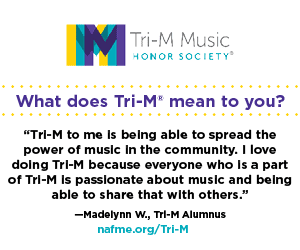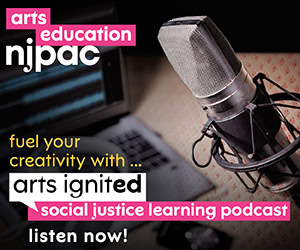/ News Posts / Top Five Percussion Tips for Concert Band Festivals
Top Five Percussion Tips for Concert Band Festivals
By Wenger Guest Author Shilo Stroman, Senior Instructor of Percussion and Jazz at Colorado State University, sponsored by NAfME Corporate Member Wenger
There is no doubt that attending a concert band festival can be a stressful situation, especially if it’s a competitive one which determines your qualification for state competitions. I’ve had the fortune of being a percussion specialist with quality concert bands performing at state festivals, state music conferences and the Music for All National Concert Band Festival. The following tips are gleaned from those experiences and hopefully will help ease some of your stress during the festival season.
Venue Provided Instruments
Get as much detail as you can about the instruments being provided by the venue. I once showed up to a venue that provided Dresden-style timpani on the performance stage. These drums have a clutch on the pedals, which created quite an issue for my students because they had never seen this type of pedal and a couple of our tunes had difficult tuning changes. Giving your students advance notice of these types of differences can help alleviate anxiety on the day of the festival.
Prioritize Familiarity
Any instrument you deem necessary for comfort level of your percussionists and/or provides a unique sound for your specific piece of music, BRING IT! I suggest making a list of instruments that can be checked off while loading and again when leaving to return back to the school. I’ve seen both scenarios, where you’re forced to borrow instruments right before an important performance, or where expensive gear gets left at the venue. Be sure to also bring plenty of black towels for mallet trays and trap stands. They’re also useful to lay on the floor underneath a snare drum if a venue has a particularly live stage.
Bring Mallets for EVERY Instrument
Even if the venue is providing concert bass drum mallets, etc, I would still bring equipment that your students are used to using every day. It will make the students more comfortable playing a foreign instrument with a mallet they’re familiar with.
Listen to At Least One Band BEFORE You Perform
This will help you and your percussion students hear what the venue sounds like and make adjustments in volume. I know venues where the triangle and tambourine appear as the loudest instruments on stage, due to their frequency range and a shell right behind the percussion section. You can further prepare students by rehearsing the possible acoustic scenarios a week or so prior to the event, that way your percussionists know how to adapt in the moment.
Setup vs. Warm Up
I prefer the percussion section set up their equipment as close to the performance venue as possible while the winds are warming up. This way, they can set up on stage quickly and get as comfortable as possible before the performance begins. It’s important to practice getting on and off the stage and also navigate transitions between pieces. It’s helpful to create diagrams of the setup and lists of which students will move to which particular instrument. Include assignments for who will make timpani tuning adjustments, turn off the snares, etc. Write ALL of this down and have hard copies in folders for the festival.
About the author:
 Shilo Stroman is a percussion performer, educator, and composer from Fort Collins, Colorado. He is the Senior Instructor of Percussion and Jazz at Colorado State University. Mr. Stroman is also very active in the marching arts and has worked with schools and corps across the United States. He is an active adjudicator and clinician for marching band and indoor percussion.
Shilo Stroman is a percussion performer, educator, and composer from Fort Collins, Colorado. He is the Senior Instructor of Percussion and Jazz at Colorado State University. Mr. Stroman is also very active in the marching arts and has worked with schools and corps across the United States. He is an active adjudicator and clinician for marching band and indoor percussion.
You can connect with Shilo Stroman on these channels:
- sstroman@mac.com
- shilostroman.com
- Instagram: @strodrum
- Twitter: @the_stro
- youtube.com/c/ShiloStroman
Did this blog spur new ideas for your music program? Share them on Amplify! Interested in reprinting this article? Please review the reprint guidelines.
The National Association for Music Education (NAfME) provides a number of forums for the sharing of information and opinion, including blogs and postings on our website, articles and columns in our magazines and journals, and postings to our Amplify member portal. Unless specifically noted, the views expressed in these media do not necessarily represent the policy or views of the Association, its officers, or its employees.
Published Date
December 12, 2023
Category
- Ensembles
Copyright
December 12, 2023. © National Association for Music Education (NAfME.org)





